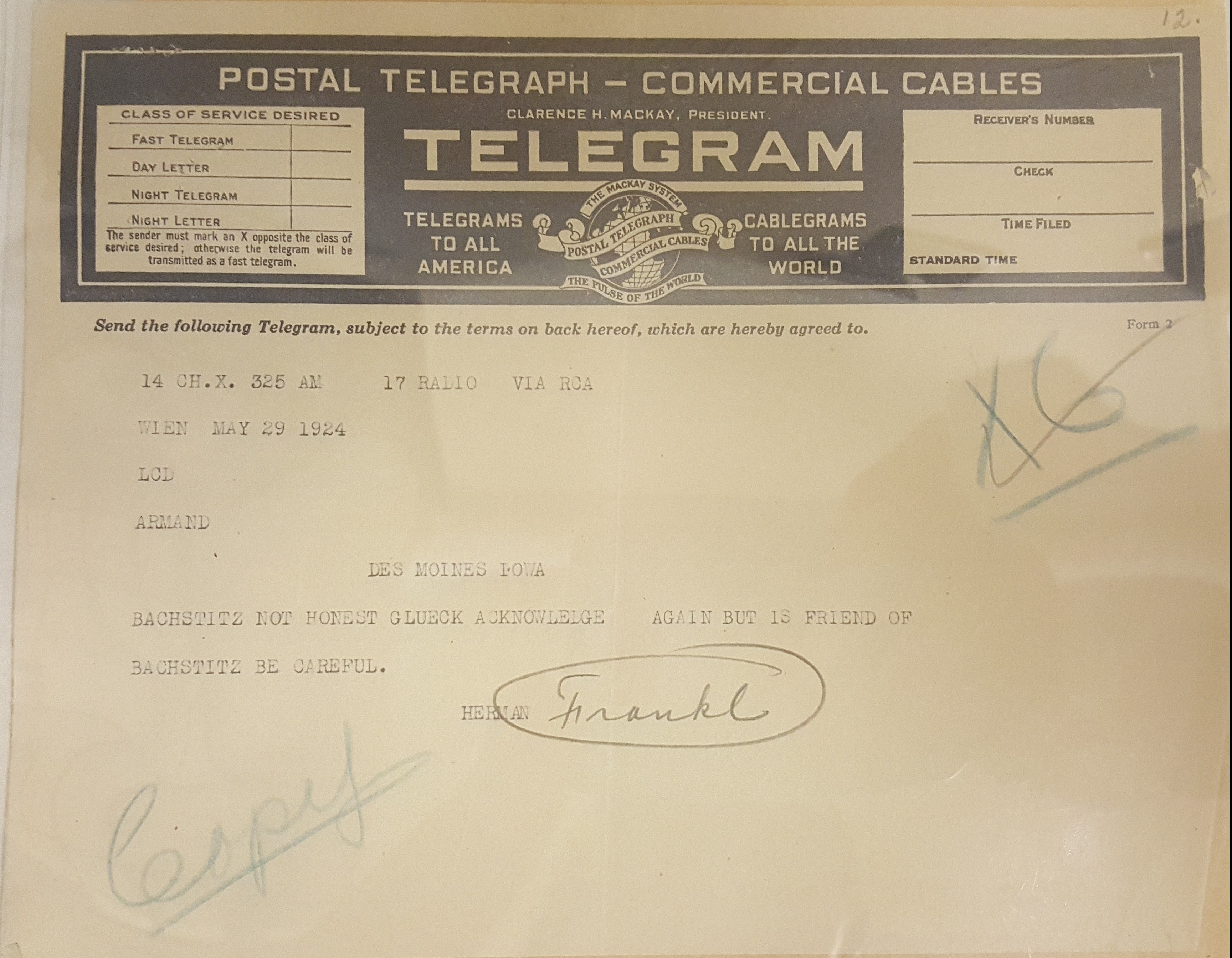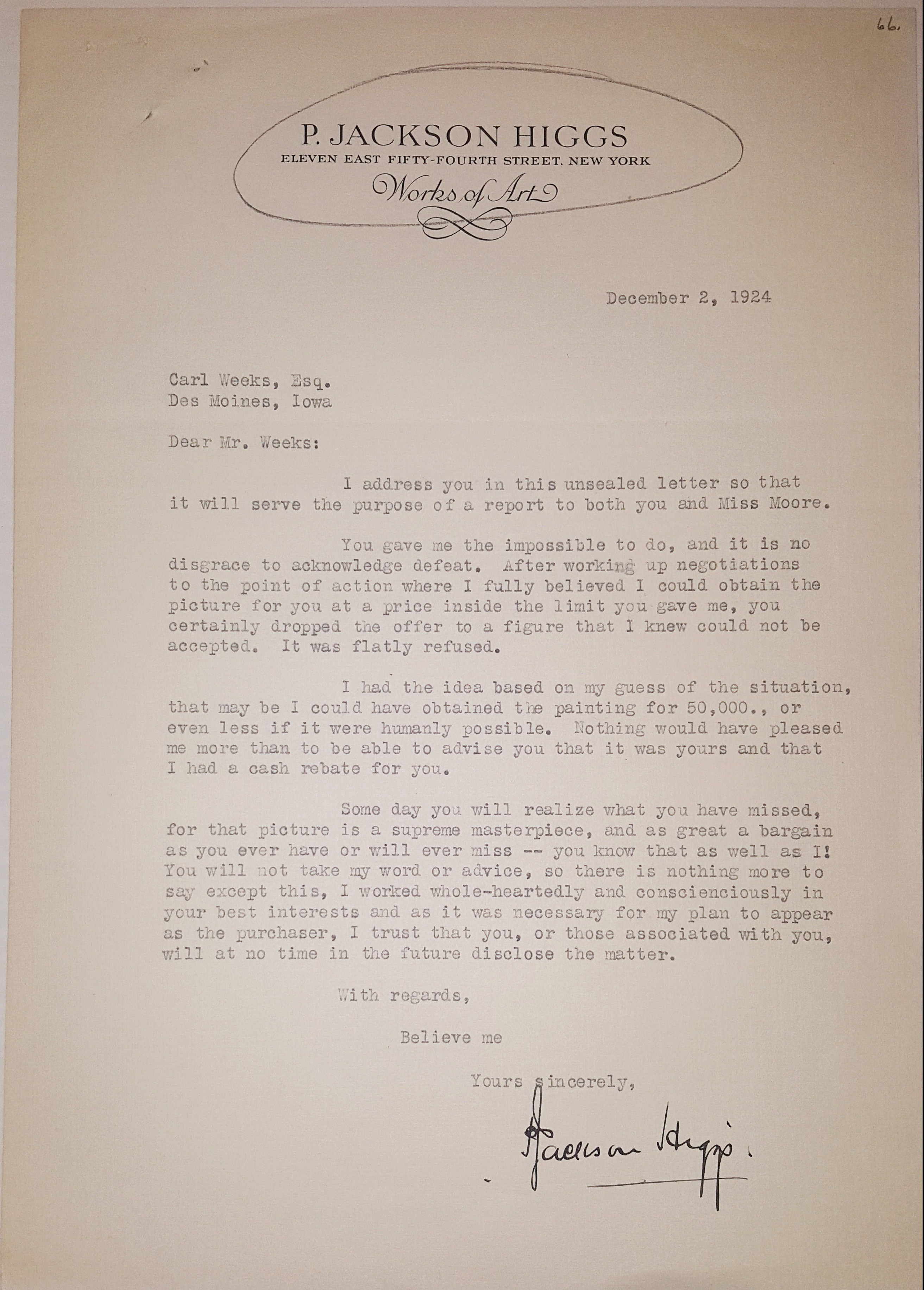Anthony Van Dyck, a Flemish painter active in the early seventeenth century, was famous for his realistic, non-embellished portraiture. Van Dyck’s style caught the eye of Cardinal Domenico Rivarola, a wealthy and notable Roman Catholic Cardinal who commissioned Van Dyck to paint his portrait in 1624.
The Cardinal’s portrait is a wonderful example of Van Dyck’s work. Does it catch your eye? In early 1924, it caught the eye of Carl Weeks, who saw the painting in the Jackson. P. HiggsGallery in New York (the Higgs Gallery was part of the larger and prestigious Bachstitz Gallery in The Hague). Carl would buy the painting for the Salisbury House, but not until almost a year later, and through what Higgs ultimately described as “devious ways.”
Before we begin our story, let’s introduce some significant players:
- Mr. Anthony Van Dyck– Flemish artist
- Cardinal Domenico Rivarola– Cardinal who commissioned the portrait
- Mr. Carl Weeks– founder of Salisbury House; art collector
- Mr. Kurt Walter Bachstitz– Notable European art dealer active in the 1920s whose main gallery was located in the Hague, Netherlands
- Mr. P. Jackson Higgs- Art dealer from New York City under Bachstitz; would later form his own gallery
- Dr. Gustav Glueck– Austrian art historian who helped confirm the portrait’s authenticity
- Mr. Wilhelm von Bode– German art historian who helped confirm the portrait’s authenticity
- Mr. Henry Reinhardt– U.S. art collector, influential in the creation of art museums in the American West; created Reinhardt and Son art gallery; died 1921
- Mr. Paul Reinhardt Son of Henry Reinhardt; Carl works with him to secure the portrait
- Mr. Hermann Frankl- Austrian art dealer and personal friend to Carl
- Mr. Landeck- Agent working for Reinhardt and Son
- Ms. Moore and Ms. Carlin- Secretaries to Carl and the Armand Co.
- Dr. Wendland- Originally sold the Cardinal to Bachstitz
Thus, our story begins with Carl’s decision to stop into the Higgs Gallery in New York in the early months of 1924. At that time, the price of the painting was $80,000. On March 14, 1924, Higgs reaches out to Carl and offers him a brochure on Van Dyck.

Carl writes Higgs back a few days later and expresses his interest in the painting, though he declined to buy it at the time due to his current financial situation with building the massive Salisbury House (1923-1928).
Higgs, realizing the value of the Cardinal Rivarola painting, urges Carl to make the choice soon so he doesn’t miss out. On March 31, 1924, Carl writes to Higgs offering $10,000 cash and $75,000 stock in the Armand Co. Higgs writes back to Carl on April 8, informing him Bachstitz did not accept the offer, and has not put the portrait up for sale in Europe yet. Higgs urges Carl to act quickly.

Carl understands there is real value in the Cardinal portrait, but is worried over the low price he was offered: Carl believes if the Cardinal Rivarola were a true and authentic Van Dyck, it would sell for a much higher price. Throughout the month of March, Carl is unsure of the painting’s authenticity. He wants the piece, but isn’t willing to pay for a fake.
On April 9, Carl writes his Austrian friend Hermann Frankl and asks him to approach Dr. Glueck (without using Carl’s name) to ask about the validity of the painting. Then, Carl receives multiple letters from Higgs urging Carl to buy the portrait.

On May 29, Frankl telegrams Carl and warns him to be careful around Bachstitz and Glueck. The summer continues with Higgs urging Carl to buy.
On September 6, Carl writes Higgs, sharing Carl’s records of the painting’s ownership, noting and inquiring about a gap in the records. Carl also writes back to Frankl and inquires why he shouldn’t trust Bachstitz and Glueck. Frankl writes Carl back, describing Bachstitz’ bad European reputation and Glueck’s good one.

On September 29, Higgs responds to Carl about the records of the Cardinal’s ownership to help Carl fill in the gaps.
The same day, Carl writes Frankl asking if he would try to buy the Cardinal from Bachstitz at a lower price than $80,000, making sure to leave Carl’s name out of the picture. At this same time, however, Carl has another plan set with Higgs, who plans to get Bachstitz to sell to him at a cheaper price, and then sell the paining Carl. On November 19, Higgs writes Carl their plan is still on.

Meanwhile, Carl is using another agency, Reinhardt and Son, to investigate the painting further. On November 24, Carl telegrams them asking what they have discovered.
Reinhardt telegrams back the same day to let Carl know the investigation is still underway, and that they could also buy the portrait at a price cheaper than was offered to Carl (another interesting aspect to this issue is that two portraits of the Cardinal Rivarola were made by Van Dyck: one for the Church, and one for the Cardinal’s personal home. Salisbury House remains in possession of the portrait acquired by Carl, while the other is housed at the Portland Art Museum.)

Carl and Landeck (the agent working for Reinhardt and Son) have a telephone conversation two days later discussing the price of the Cardinal and how Carl plans to acquire it. The same day, Carl writes Landeck asking him if he could get the Cardinal for under $60,000.
On November 27, Higgs telegrams Carl that the auction for the Cardinal is a week away, and that Bachstitz may go low or as high as $100,000. On November 28, Landeck telegrams Carl to assure him $60,000 is probably a fair price, though he is fairly certain they can get it for $50,000. Landeck tells Carl that he thinks Higgs may still be selling for Bachstitz and tells Carl to use his own judgment when dealing with Higgs.

On December 2, Higgs writes to Carl he has missed out on the portrait for offering too low of a price. On December 10, Bachstitz writes Carl that the gallery’s contract with Higgs was officially over, and negotiations for the portrait would now be through Bachstitz. Carl offers Bachstitz $30,000, and informs Reinhardt and Son.


On January 20, 1925, Landeck writes Carl to let him know they have brought in another player, Dr. Wendland, who originally sold the Cardinal’s portrait to Bachstitz. Wendland is now working with Carl and Reinhardt and Son to help Carl acquire painting.
Wendland, acting secretly as Carl’s agent, offers Bachstitz 200,000 Swiss francs for the piece, plus a 10% commission for two reasons: the francs to make Bachstitz think the piece was being sold in the Netherlands, and the commission to make him think he is selling it to a personal client.
Carl authorizes Landeck to go up to 220,000 Swiss francs, if necessary. The same day, Landeck phones Carl letting him know Bachstitz would do 125,000 Dutch guilder, but Wendland believes they can get the deal for 200,000 Swiss francs, and he declines the offer. Wendland counter-offers the same 200,000 Swiss francs, but without the 10% commission, which he believes Bachstitz will accept.

Carl writes to Bachstitz on January 26 that he is not longer interested in purchasing the Cardinal, though on January 31, Carl telegrams Bachstitz his offer for the Cardinal at $30,000 is still on the table. On February 4, Reinhardt and Son gallery receives the portrait.

On February 13, Bachstitz writes Carl that the Cardinal has been sold to someone else, and is sorry Carl missed out on it.
On March 3, Carl replies to Bachstitz that he believes he will be the owner of the portrait eventually.
On March 11, Higgs writes Carl that the Cardinal sold, and asks if Carl bought the painting through “dubious” ways. Carl writes back on March 13, stating it was the Reinhardt and Son Gallery, not Carl, who got the Cardinal, though they were saving it for him until his next New York visit.
For nearly a year, Carl engaged in a various methods of subterfuge or, depending on your perspective, strategic business tactics, in order to secure his ownership of this Van Dyck painting.


The deal was ultimately a success from Carl’s point of view. He had originally encountered the Cardinal in early 1924 at the Higgs (Bachstitz) Gallery and it was offered to him for $80,000. In 2017, that would be about $1,200,000. Carl thought he could get a better deal from his Austrian friend and small-time art dealer, Mr. Frankl, whom Carl asked to buy the painting on his behalf at a cheaper price. Carl saw an even better opportunity through the Reinhardt Gallery, who promised a good deal on the painting by going through their agency. Finally, after Reinhardt’s associate, Dr. Wendland, was able to “buy back” the Cardinal from Bachstitz (to whom Wendland originally sold it), Carl was able to snag the Cardinal for only 200,000 Swiss Francs, or $36,595.
Today, we are incredibly fortunate that the Cardinal still adorns the walls of Salisbury House. Plan your visit here!